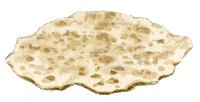Flatbrød

Form: Sheet of bread
Country of origin: Norway
What distinguishes it from other methods of bread making: Thin barley or rye dough cooked on a hot metal plate or in the oven
Category of bread: (1, 4 and 7) When fresh, it is similar to Ethiopian injera or Sardinian carasau, but because it dries out very quickly, it falls into the category of dry breads (crackers), similar to its Swedish cousin the knäckebröd
Particularity: For a long time, it was the staple food of the Norwegians
Ingredients: Wheat flour; leaven or yeast; milk; sugar; salt; hot water. For the glaze: rice flour; oil; sugar; salt; yeast; hot water.

Norway
Unlike flat breads, these leaves of bread have the property of drying in a flash. For this reason it is preferably categorized as a bread that is “nomadic” in that it is taken with voyagers who for one reason or another can’t get fresh food supplies for a long period of time. Flatbrød was therefore initially the bread eaten by shepherds, people who lived in isolated places in the country, or prisoners during winter. Under the name soppebrød, it was eaten with every possible kind of soup in which it was dunked or soaked. That tradition continues today.
But let’s come back to now to traditions and cuisines that are part of a national identity. There is no doubt that flatbrød carries with it something that is profoundly Norwegian. When we look at it this way, we go back to the method of making bread adopted by bakers in each country, using barley, oats, rye or wheat or a mixture of these grains. We soon realize that recipes revolve around a reference model belonging to popular wisdom passed down through oral history, which has somehow disappeared. This means we have to try and catch the range of possibilities, i.e. the “spirit” of flatbrød.
In fact, it consists of very little: flour that is often little or strictly not suitable for bread making, such as barley; a fermenting agent, which may be leaven or baker’s yeast, or even baking powder; fat, which often consists of buttermilk, but sometimes butter or lard; a pinch of salt, which can be done away with if necessary. The resulting dough is left for the time it needs for its first fermentation. It is then rolled out into a sheet that can be cut into smaller pieces as required. These dough sheets are cooked on hot metal plates or in the oven at low temperature.

